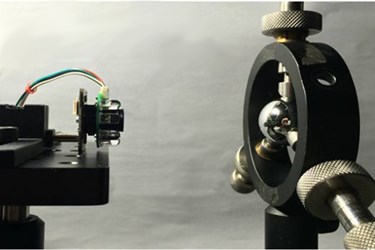Wearable Device Could Provide Early Detection Of Diabetes-Related Complication
By Joel Lindsey

A research team in Taiwan that includes scientists from National Taiwan University Hospital and National Chiao-Tung University has created a device called a pupillometer designed to measure certain conditions in the wearer’s pupil in order to predict the early onset of a complication related to diabetes.
“Compared to the existing diagnostic techniques, the pupillometer is a more reliable, effective, portable, and inexpensive solution for diagnosing diabetic autonomic neuropathy in its early stages,” Mang Ou-Yang, lead researcher on the project, said in a press release published recently by The Optical Society (OSA).
The device weighs 78 grams and can be attached to eyeglasses worn by diabetic patients who would wear the device for approximately thirty minutes. During that time, the pupillometer would emit four colored lights into the wearer’s eye to stimulate the pupil. A beam splitter would then filter the visible light being reflected by the pupil. Using a miniature camera, the device could record this reflected and filtered light and analyze the pupil size.
According to researchers involved with the project, the device enabled them to measure and study 10 parameters related to the eye’s responses to light stimulation. In particular, they discovered that five of those parameters were consistently different in people with diabetic autonomic neuropathy, a complication that arises from diabetes and that affects the nerves in charge of regulating the heart, the gastrointestinal system, and other important organs.

A prototype pupillometer designed for a patient to wear for a half hour or so in a doctor's office and test for diabetic autonomic neuropathy. It may help diagnose the condition sooner, leading to better treatment outcomes. Credit: M. Ou-Yang, National Chiao-Tung University, Taiwan.
In early tests of the new device, the results of which have been published in the OSA’s journal Applied Optics, researchers found that testing pupils with the pupillometer could provide a way to generate early diagnoses of diabetic autonomic neuropathy, which they say could improve the chances of effectively treating the disorder before it becomes serious.
The study “presents a novel wearable pupillometer design, without external light artifacts, and an embedded algorithm with blinking elimination, which investigates autonomic neuropathy through recording pupil dynamics triggered by an external sensitive invisible light source,” the research team wrote. “The pupillometer is proven reliable, effective, portable, and inexpensive for diagnosing diabetes in an early stage.”
Researchers now plan to focus on scaling down the size of the pupillometer and developing a way to monitor two pupils at the same time in order to collect even more data. If all goes well, the device could move into the market by the end of the decade, according to the press release.
